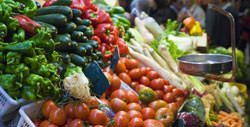

Photo courtesy iStockphoto/Thinkstock
Hotel culinary staff seek out fruits, vegetables, dairy items and meats at farmers markets and local farms.
At some hotels, food choices are the result of culinary staff trolling farmers markets or dialing up local farms in search of juicy fruits, earthy vegetables, artisan dairy items and mouth-watering meats.
A few months before W Austin, in Austin, Texas, opened in December of 2010, Valerie Broussard was hired as its forager. Her goal? To source all food and beverage products — right down to the wine, olive oil and edible flowers — from within 50 miles, with the exception of seafood (mostly shrimp, oysters and crab), which comes from the Gulf of Mexico. This includes everything edible and shippable that is served at meetings, delivered via room service and on the menu at Trace (the hotel’s restaurant).
Shortly after she was hired, Broussard put the foraging mantra to work on the hotel’s mini bar and “munchie box” contents in each of the 251 rooms. “I was able to find a few local products,” says Broussard, who spent 11 years in New York City as a chef, food stylist and writer, later earning a master’s degree in food culture and communications from the University of Gastronomic Sciences in Parma, Italy. “I thought it made sense to put local flavor in the room.”
Austin-made jars of salsa, nuts, vodka and liqueurs were among the items that made the cut.
Acting as W Austin’s forager is Broussard’s dream job. A typical day for her might mean shopping at Austin’s farmers markets and stands for impromptu ingredients, as well as calling up farmers and creating an updated list of what’s available. “I knew I didn’t want to be a chef, but I knew I wanted to work with food, and that I would find my way,” says Broussard, a Lafayette, La., native and Slow Food Austin’s Biodiversity Chair.
At Trace, which serves breakfast, lunch and dinner, she works in tandem with Chef de Cuisine Paul Hargrove. On this past New Year’s Eve, Hargrove put in a request to Broussard for black radishes. She instantly knew what farmer to call.
Examples of her work are salads containing hydroponically grown lettuces from Blue Bonnet Hydroponic, yogurt in a granola parfait from an Austin-area creamery, and Texas-made olive oil for dipping breads are all options for diners. Cups of tea are brewed using Zhi Tea, a tea purveyor in Austin.
Another hotel heavily into foraging is Fairmont Miramar Hotel & Bungalows in Santa Monica, Calif. Conveniently located near the Santa Monica Farmers Market, and in the thick of agricultural regions, Los Angeles forager Kerry Clasby logs many miles on her car — she’s a contracted professional forager, not on staff — to find ingredients that Chef Ray Garcia uses at FIG, the hotel’s restaurant. Products harvested from about 30 different farms end up on the menu.
Recently, she provided Garcia with torpedo onions, limequats, black dates and Egyptian flat beets. The onions she finds are used in the Lamb Couloutte, the dates on the Bordeaux Spinach and limequats on Pork Belly (a new dish on the menu).
The role of forager is an important one. It can help small, family owned farms survive, particularly those that lack the time and financial budget to market to restaurants. In some cases, farmers communicate to their restaurant customers what’s coming down the pike. This way they are ensured someone will buy that particular crop.
It also allows time for tinkering in the kitchen — as opposed to a farmer showing up with a box of, say, Peruvian potatoes, the day they’re harvested and the kitchen frantically whipping up a dish Top Chef-style. “We know what’s going in the ground, so we’ll be ready, and there’s time for recipe development and menu costing,” Broussard says.
Bringing awareness to humanely raised animals and sustainably grown vegetable and fruit crops is also important. Referring to conditions that are anything but that, Broussard says, “It’s not the way I want to eat or the food I want to source.”




